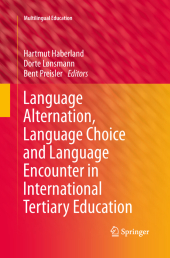 Neuerscheinungen 2015Stand: 2020-02-01 |
Schnellsuche
ISBN/Stichwort/Autor
|
Herderstraße 10
10625 Berlin
Tel.: 030 315 714 16
Fax 030 315 714 14
info@buchspektrum.de |

Hartmut Haberland, Dorte L›nsmann, Bent Preisler
(Beteiligte)
Language Alternation, Language Choice and Language Encounter in International Tertiary Education
Herausgegeben von Haberland, Hartmut; L›nsmann, Dorte; Preisler, Bent
Softcover reprint of the original 1st ed. 2013. 2015. xxiv, 241 S. 7 Tabellen. 235 mm
Verlag/Jahr: SPRINGER NETHERLANDS; SPRINGER 2015
ISBN: 9401783438 (9401783438)
Neue ISBN: 978-9401783439 (9789401783439)
Preis und Lieferzeit: Bitte klicken
Reflecting the increased use of English as lingua franca in today´s university education, this volume maps the interplay and competition between English and other tongues in a learning community that in practice is not only bilingual but multilingual. The volume includes case studies from Japan, Australia, South Africa, Germany, Catalonia, China, Denmark and Sweden, analysing a range of issues such as the conflict between the students´ native languages and English, the reality of parallel teaching in English as well as in the local language, and classrooms that are nominally English-speaking but multilingual in practice. The book assesses the factors common to successful bilingual learners, and provides university administrators, policy makers and teachers around the world with a much-needed commentary on the challenges they face in increasingly multilingual surroundings characterized by a heterogeneous student population.
Patterns of language alternation and choice have become increasingly important to the development of an understanding of the internationalisation of higher education that is occurring world-wide. This volume draws on the extensive and varied literature related to the sociolinguistics of globalisation - linguistic ethnography, discourse analysis, language teaching, language and identity, and language planning - as the theoretical bases for the description of the nature of these emerging multilingual communities that are increasingly found in international education. It uses observational data from eleven studies that take into account the macro (societal), meso (university) and micro (participant) levels of language interaction to explicate the range of language encounters - highlighting both successful and problematic interactions and their related language ideologies. Although English is the common lingua franca, the studies in the volume highlight the importance of the multilingual resources available to participants in higher educational institutions that are used to negotiate and solve their language problems. The volume brings to our attention a range of important insights into language issues found in the internationalisation of higher education, and provides a resource for those wishing to understand or do research on how language hybridity and multilingual communicative practices are evolving there. Richard B. Baldauf Jr., Professor, The University of Queensland
Notes on contributors .- Hybridity and complexity: language choice and language ideologies by Dorte L›nsmann and Hartmut Haberland .- Part I The local language as a resource in social, administrative and learning interactions . 1. Kitchen talk - Exploring linguistic practices in liminal institutional interactions in a multilingual university setting by Spencer Hazel and Janus Mortensen .- 2. Japanese and English as lingua francas: Language choices for international students in contemporary Japan by Keiko Ikeda and Don Bysouth .- 3. Plurilingual resources in lingua franca talk: An interactionist perspective by Emilee Moore, Eulàlia Borràs and Luci Nussbaum .- 4. Language choice and linguistic variation in classes nominally taught in Englis h by Hedda Söderlundh .- 5. Active biliteracy? Students taking decisions about using languages for academic purposes by Christa van der Walt .- Part II Using English as a lingua franca in teaching a foreign language . 6. English as a lingua franca: A case of Japanese courses in Australia by Duck-Young Lee and Naomi Ogi .- 7. "Teacher! Why do you speak English?" A discussion of teacher use of English in a Danish language class by Mads Jakob Kirkeb‘k .- 8. The use of English as a lingua franca in teaching Chinese as a foreign language: A case study of native Chinese teachers in Beijing by Danping Wang .- Part III Parallel language use: English and the local language . 9. Stylistic and pedagogical consequences of university teaching in English in Europe by Jacob Th›gersen .- Part IV Language policies and language ideologies in international education . 10. Expanding language borders in a bilingual institution aiming at trilingualism by Enric Llurda, Josep M. Cots and Lurdes Armengol .- 11. Language practices and transformation of language ideologies: Mainland Chinese students in a multilingual university in Hong Kong by Michelle M. Y. Gu


